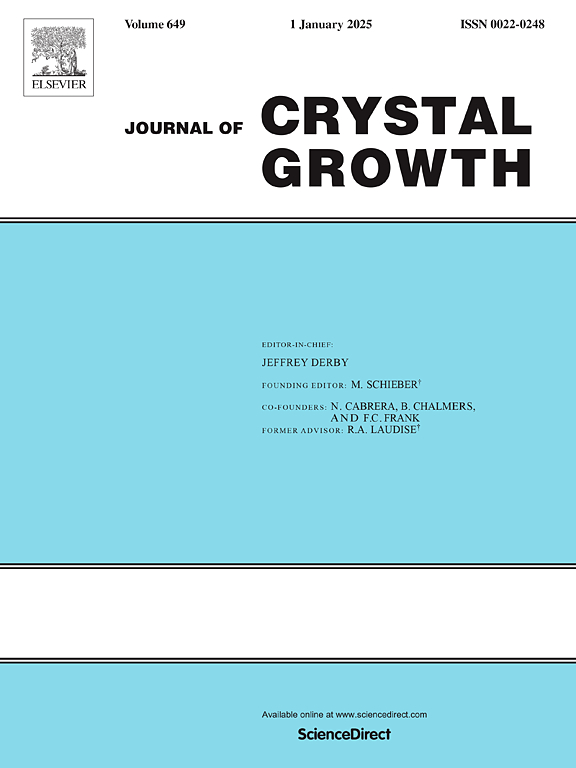碘化铯和氟化钙的克佐克拉尔斯基生长数值模型的验证
IF 1.7
4区 材料科学
Q3 CRYSTALLOGRAPHY
引用次数: 0
摘要
CZ生长过程的数值模拟,包括电磁、传热、相变和熔体流动的多物理相互作用,是工艺开发和优化的重要工具。然而,由于缺乏原位测量数据,这些模型的验证大多不足,而且很难获得开源模型。为了解决这些问题,使用开源工具Elmer开发了一个新的2D和3D CZ增长模型,用于全球时谐电磁学,稳态传热和相变建模,以及用于瞬态或稳态熔体流动建模的OpenFOAM。该模型是在开源许可下发布的。通过针对氧化物/氟化物材料的碘化铯(CsI,熔点:627°C)模型实验,重点验证了该模型的电磁学和传热。对于二维模型,在晶体直径不变的区域,坩埚温度和晶体温度的模型实验与模拟结果吻合较好。利用三维模型,观察了感应加热器磁场不对称导致坩埚温度分布不对称所引起的三维流动规律,与实验结果吻合较好。然而,两种模型产生的加热器电流比实验中观察到的高38%。讨论了验证结果对氟化钙(CaF2)生长激光冷却应用的可转移性。对CaF2的生长过程进行了三维建模,以研究实验中观察到的粗糙晶体表面的原因。这可能是由旋转的三维流动结构引起的,而保温和加热器中的观察窗口对温度分布的影响较小,从而对晶体表面结构的影响较小。本文章由计算机程序翻译,如有差异,请以英文原文为准。

Validation of a numerical model for Czochralski growth of cesium iodide and calcium fluoride
Numerical modeling of the Czochralski (CZ) growth process, which includes the multiphysical interactions of electromagnetism, heat transfer, phase change, and melt flow, is an essential tool for process development and optimization. However, validation of such models is mostly insufficient due to the lack of in-situ measurement data, and open-source models are hardly available. To address these issues, a new 2D and 3D CZ growth model has been developed using the open-source tools Elmer for global time-harmonic electromagnetism, steady-state heat transfer and phase change modeling, coupled with OpenFOAM for transient or steady-state melt flow modeling. The model is published under an open-source license. The model is validated with a focus on electromagnetism and heat transfer using a model experiment with cesium iodide (CsI, melting point: 627 °C), targeting oxide/fluoride materials. For the 2D model, a satisfying agreement between model experiment and simulation regarding crucible and crystal temperature is achieved in regions with constant crystal diameter. With the 3D model, 3D flow patterns caused by an asymmetric crucible temperature distribution due to an asymmetric magnetic field of the induction heater are observed and in reasonable agreement with the experiment. However, both models yield heater currents up to 38 % higher than those observed in the experiment. The transferability of the validation results to calcium fluoride (CaF2) growth for laser cooling application is discussed. The CaF2 growth process is modeled in 3D to investigate the cause of a rough crystal surface observed in the experiment. It might be caused by a rotating 3D flow structure, while the observation window in the insulation and after-heater is of low influence on the temperature distribution and, thus, the crystal surface structure.
求助全文
通过发布文献求助,成功后即可免费获取论文全文。
去求助
来源期刊

Journal of Crystal Growth
化学-晶体学
CiteScore
3.60
自引率
11.10%
发文量
373
审稿时长
65 days
期刊介绍:
The journal offers a common reference and publication source for workers engaged in research on the experimental and theoretical aspects of crystal growth and its applications, e.g. in devices. Experimental and theoretical contributions are published in the following fields: theory of nucleation and growth, molecular kinetics and transport phenomena, crystallization in viscous media such as polymers and glasses; crystal growth of metals, minerals, semiconductors, superconductors, magnetics, inorganic, organic and biological substances in bulk or as thin films; molecular beam epitaxy, chemical vapor deposition, growth of III-V and II-VI and other semiconductors; characterization of single crystals by physical and chemical methods; apparatus, instrumentation and techniques for crystal growth, and purification methods; multilayer heterostructures and their characterisation with an emphasis on crystal growth and epitaxial aspects of electronic materials. A special feature of the journal is the periodic inclusion of proceedings of symposia and conferences on relevant aspects of crystal growth.
 求助内容:
求助内容: 应助结果提醒方式:
应助结果提醒方式:


